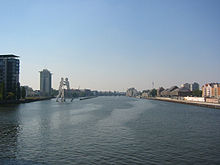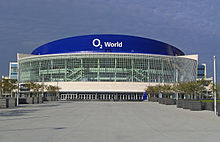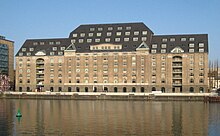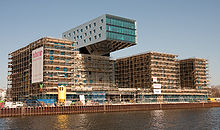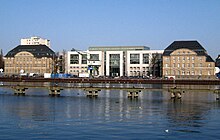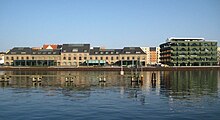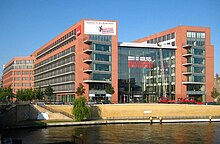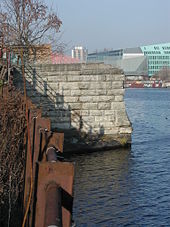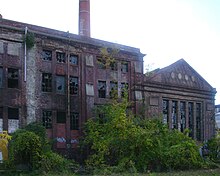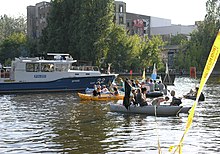Mediaspree

Mediaspree is one of the largest investor projects in Berlin . It aims to locate communication and media companies along part of the banks of the Spree and to restructure this area accordingly . Office buildings, lofts , hotels and other new buildings are to be built on mostly unused or temporarily used land .
Most of the plans date from the 1990s, but were only partially implemented because of the poor economic situation at the time. The initiators see the project as a great opportunity for East Berlin , while critics see the sale of its most valuable spaces. Mediaspree defined the following criteria for sustainable site development:
- A public bank use,
- Buildings with public areas on the ground floor,
- Mixture of large-scale and small-scale use,
- sophisticated architectural concepts
- Integration of art and media.
Organizational administration
There is no institution that centrally manages and markets the project; Mediaspree is just a label . The planning of the individual construction projects lies with the property owners, investors and districts (in particular Friedrichshain-Kreuzberg ).
However, in May 2004, the regional management association mediaspree e. V. (originally media spree Berlin GmbH ), which existed until December 2008.
It emerged from a private-sector initiative as an amalgamation of various interest groups: investors from the construction and real estate industry, property owners who had acquired the fallow land in the former border area after the political change , as well as representatives of the Senate, the district and the Chamber of Industry and Commerce . The Friedrichshain-Kreuzberg district was not in the lead, but a partner in the sense of the public-private partnership . Membership in the association was restricted to owners, tenants and tenants of land or real estate in the Spree region. In 2008 Mediaspree e. V. 21 members, including the Anschutz Entertainment Group , Behala , the Berliner Stadtreinigungsbetriebe , Deutsche Post Immobilien , GASAG , IVG Immobilien and TLG Immobilien .
The association saw its task in mediating rooms and areas for the corresponding Spree area, advising resident companies and companies willing to settle, arranging contacts with owners, authorities and sponsors and taking measures for marketing and image building.
After the end of public funding, Mediaspree e. V. dissolved on December 31, 2008. Its tasks are now being carried out by a local community that has been newly constituted, but continues to operate under the name Mediaspree .
The Berlin Senate Department for Urban Development and the Environment is now running its planning for the area on both sides of the Spree under the heading “Spreeraum model”.
location
The project relates to an area around 3.7 kilometers long and 180 hectares on both banks of the Spree on the borders of the districts of Mitte , Friedrichshain , Kreuzberg and Alt-Treptow . It is bounded in the west by the Jannowitzbrücke , in the north by the railway line, in the east by the Elsenbrücke and in the south by Schlesische Strasse and Köpenicker Strasse. The Spree is around 150 meters wide in this section and its banks are relatively straight. It is crossed by the Michaelbrücke , the Schillingbrücke and the Oberbaumbrücke . In addition to large, undeveloped areas, there are numerous industrial and commercial buildings from the 19th and early 20th centuries, such as the egg cold store at the Osthafen and the ice cream factory , various new buildings and the East Side Gallery . The area is well connected to the local and long-distance traffic network by public transport.
history
In the 19th and early 20th centuries, the area was primarily home to industry and commerce. Many of the buildings that still exist today date from this period and are characteristic of their era. Some of them are therefore now listed . Before the Second World War , the Osthafen, which opened in 1913 with extensive storage facilities for grain and other goods, the egg cold store and the ice cream factory, were of particular importance for the region .
Between 1939 and 1945 the area was mainly used by the Wehrmacht . The port served as a cargo handling point, and tanks and other war material were serviced in what is now the Arena Berlin event hall at Treptower Park , a former omnibus hall. More than 150 prisoners of war and foreign workers worked on the port site.
After the war, large parts of the buildings were destroyed. Until 1947, large areas were confiscated and used by the Soviets, transportable material was dismantled and brought to the Soviet Union as part of the reparation claims .
During the Cold War , the site was in the middle of the border area between East and West Berlin , which made economic development impossible. On the GDR side, parts of the industrial buildings were included in the border security by means of watchtowers and the like. The Berlin Wall ran on the northern bank of the Spree parallel to the river, which was the official border. On the West Berlin side, various alternative projects were developed in the Kreuzberg district bordering the Spree to the south .
The reorganization of the area after the fall of the Wall began only slowly. An approximately 1.3 kilometer long section of the Berlin Wall was not demolished, but designed by artists and has been the longest open-air gallery in the world as the East Side Gallery since 1990 . From 1998 the Ostbahnhof was rebuilt and reopened in 2000. Much of the fallow land was bought by investors. However, a decisive development did not begin until 2002 with the approval of a land use plan by the Berlin Senate and the advancement of the Mediaspree project .
overview
The first investor projects implemented in the Mediaspree area after the fall of the Berlin Wall include the construction of the Treptowers , the ver.di headquarters on the Schilling Bridge, and the conversion of the egg cold store into the German headquarters of Universal Music , which was funded by the Senate with ten million euros and in mid-2002 was completed. In the spring of 2004, MTV Networks Germany , which was also subsidized, was relocated to a former warehouse at the Osthafen. VIVA and VIVA Plus followed in 2005 due to their takeover by the MTV Group. On the area of the former Ostgüterbahnhof, the then O 2 World Berlin was built by the Anschutz Entertainment Group (today: Mercedes-Benz Arena) and opened on September 10, 2008, accompanied by protests.
More already completed construction and remodeling projects Mediaspree area include the Energy Forum Berlin , the Industrial Palace at the Warsaw street , the European Shared Service Center of BASF in the Oberbaumcity , the TV shipyard , the renovation of the Victoria Mill , the Wissinger yards , the former army bakery and the Josetti-Höfe . However, are not finished yet, among other projects Spree Urban and Spreeport , the Columbus House, the development of the postal area to the postal station, the Anschutz -Gelände, the district in Orange of the BSR , the future fashion house label 2 , the planned marina, the new Spreespeicher and the renovation of the ice cream factory .
For recreational purposes, Mediaspree has planned a ten-meter-wide strip of banks and a park on the Spree, as well as some smaller pocket parks between the Spree and Stralauer Allee around the East Side Gallery. In addition, promenades and cycle paths are planned on both sides of the river. On the other hand, after protests, a re-erection of the destroyed Brommy Bridge to relieve the increasing traffic volume was refrained from - instead, a temporary "artificial footbridge" is to be built.
Urban redevelopment west
Mediaspree goes hand in hand with the Senate Project Urban Redevelopment West , which, in addition to the restructuring of the Kreuzberg bank of the Spree, is also explicitly committed to the development of the Neukölln-Südring, Schöneberg-Südkreuz and Tiergarten-Nordring / Heidestrasse areas. The Federal Government and the State of Berlin want to counteract the negative consequences of economic and demographic change by promoting “private investments and sustainable jobs”.
Projects already implemented
Property descriptions largely according to
Northern bank of the Spree from west to east
Fortress Multi Service Center
Launched by the Meerbusch Fortress Immobilien AG built, next to to Holzmarktstrasse 1-9 Station Berlin Jannowitzbrücke located, new multi-service center includes a Tamoil - gas station , a Burger King with drive-in, a Lidl - discount stores and offices. The investment volume was 8.3 million euros.
Triad

The Trias at Holzmarktstrasse 15–17 was built from 1994 to 1996 by the architects Lucia Beringer and Gunther Wawrik and since August 2008 has housed the head office of the Berliner Verkehrsbetriebe (BVG). It consists of three 13-storey office towers and a six-storey wing.
Ibis Hotel
The seven-storey building complex directly on the Schillingbrücke was completed in 2000 and consists of three parts, in which there is commercial space, 20 apartments and the Hotel Ibis Berlin City Ost with 242 rooms.
EnergieForum Berlin
The building at Stralauer Platz 33/34 was built between 1906–1908 and used to house the central warehouse of the municipal gas works . By 2002 it was rebuilt as EnergieForum Berlin with the thematic focus on regenerative energies and the rational use of energy, and a new building was added. It opened on October 28, 2003. The listed warehouse building and two modern structures on the Spree were connected by a glass atrium . Companies and institutions have settled here that distinguish themselves nationally and internationally in the field of environmentally friendly and regenerative energy generation and use and use the EnergieForum as an office building and event location.
East Side Park
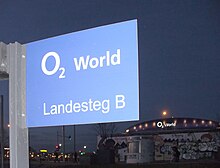
The East Side Park is located between the East Side Gallery and the Spree. Like the planned park on the Spree (see below), it was commissioned by the Friedrichshain-Kreuzberg district office and designed by the Häfner / Jiménez office for landscape architecture . In its center is the so-called “Boat Landing Plaza” - a landing stage built for O 2 World Berlin. The park is around 1.5 hectares and was realized from August 2006 to spring 2009. The construction costs amounted to 816,000 euros.
The facility is divided into two levels; the upper one is defined by the monument area of the Berlin Wall and the former control route. In its sparse design, it should be a reminder of the death strip that used to run here . The East Side Gallery designed on the wall has been repaired since October 2008. The second system level is a promenade directly on the water. In between, sunbathing lawns were created that slope down to the Spree.
The main criticism of the East Side Park was the landing stage for O 2 World Berlin, for which a 45 meter long section of the listed East Side Gallery had to be removed. In addition, an advertising board was built at this point, which is perceived as annoying due to its dimensions, its light intensity and its position in the line of sight between Oberbaumbrücke and television tower .
Mercedes-Benz Arena
The Mercedes-Benz Arena (formerly: O 2 World) Berlin at Mühlenstrasse 12-30 is the second largest multifunctional hall in Germany after the Lanxess Arena in Cologne , with up to 17,000 seats and standing room . The foundation stone was laid on September 13, 2006; the opening ceremony, which was accompanied by protests, took place on September 10, 2008. The building owner and operator is the Anschutz Entertainment Group. The construction costs are estimated at around 165 million euros and were partly taken over by the Senate. The naming partnership with O 2 (Germany) lasted for 15 years and was taken over by the Baden-Württemberg car maker Mercedes-Benz in July 2015 before the end of the contract .
The ice hockey club Eisbären Berlin and the basketball club Alba Berlin have played their home games there since the arena opened . It is also used for concerts and meetings. The Mercedes-Benz Arena Berlin is one of the most criticized projects in the Mediaspree . The large-scale and light-intensive advertising installations as well as the less sensitive approach to building the hall (see East Side Park ) are particularly disruptive .
BSR customer service center
The customer service center of the Berliner Stadtreinigungsbetriebe (BSR) is part of the district in Orange, which is still being planned (see below). It has moved into an ensemble at Mühlenstrasse 9/10, which consists of a new building and a residential building that has been converted into an office building. The buildings and the BSR depot located on the site are connected to each other by passages on two floors. In the immediate vicinity there are also garages and parking spaces for the vehicles of Ruwe GmbH , which has its administrative headquarters on Warschauer Straße .
Industrial palace
The industrial palace at Warschauer Strasse 34–44 was built from 1906 to 1907 according to plans by Johann Emil Schaudt . It is a storey factory typical of its time, an iron skeleton structure that connects five individual buildings to form an overall complex.
From 1992 to 1993 the listed facade of the industrial palace was redesigned. The house numbers 43/44 were extensively renovated as part of the Mediaspree project and a new building was added, which is optically based on the historical building. The floors were expanded as office space, so that a total of 3,500 m² of office and commercial space was created.
Toyota dealership
The Toyota car dealership at Stralauer Allee 44-47 was built with an investment volume of 10 million euros and opened in November 2007. New and used cars are presented on a floor space of around 2,800 m². There is also a workshop for cars from the luxury brand Lexus , which is part of the Toyota Group, at the site .
Universal Music's German headquarters ( egg cold store )

Since July 2002 the German headquarters of the music company Universal Music has been located at Stralauer Allee 1 in the former egg cold store, which was built in 1928/1929 according to plans by the Dresden building councilor Oskar Pusch . The functional and listed facade of the cold store bears the characteristics of the Bauhaus architecture: a 25 cm thick clinker brickwork with a diamond pattern as a decorative element and cornices on the corners of the building. After its closure, the Berlin port and warehouse operations BEHALA decided in 1992 to re-use the cold store and the neighboring granary (see below). From 1995 there were plans to combine the two into one building complex and use them as a business design center , but these were never realized.
From 2000 to 2002 the cold store was converted into an office and commercial building by the Berlin architect Reinhard Müller. Here, the originally closed façade has been opened over a large area on three sides and with a curtain provided glass facade. Only the front facing northwest towards the Oberbaumbrücke still has a closed clinker brick facade. The historical style elements of the windows, capped ceilings and walls have been preserved. Originally it was planned to provide the glass panes with a rasterized diamond pattern in order to achieve a closed facade appearance in terms of monument protection. However, due to problems with the exposure of the inner areas, this was ultimately omitted. In addition to Universal Music, various other media and service companies have moved into the building.
Office lofts in the granary
The granary, built from 1907 to 1913, was designed by the Berlin architect Friedrich Krause, who had already implemented the port facility in Szczecin . With the huge hipped roof , clinker brick surfaces and natural stone, he chose the classicist construction method typical of that time .
The building was used as a warehouse until 1990, after which it stood empty for a few years. After the building permit was granted in May 2000, it was completely renovated by March 2001, whereby the historical style elements of the windows, capped ceilings and walls were retained. Additional stairwells and elevators as well as an underground car park were newly built. Offices and office lofts were set up over all eight floors on a total of 18,000 m², which apparently aroused great interest among tenants - there is currently no free rental space available.
NH hotel
Immediately to the east of the former granary (see above), the project developer Nippon Development Corporation (now: NDC Projektentwicklung ), based in Berlin, built a new four-star congress hotel with 310 rooms and a large conference center with around 2000 square meters. The nhow Hotel is operated by the NH Hotel Group from Madrid. The building design comes from the architects nps tchoban voss and consists of two structures connected by a transparent walkway. A three-storey cube with silver-colored metal cladding was placed over a traditional substructure with a perforated facade and clinker cladding. The component, which is mirrored on the underside, protrudes 25 m towards the Spree without any additional support structure. A complete recording studio with a recording booth is installed on the upper floors. The spectacular interior was designed by Karim Rashid from New York, who transformed the interior into a colored OP art work of art. The project received the full support of the Friedrichshain-Kreuzberg district office and was completed in October 2010 after only two years.
Coke
Right next to the NH hotel is the newly built office building, which has been the headquarters of Coca-Cola GmbH in Germany since March 2013.
Oberbaum City
The area around the former Narva lamp factory in the Berlin district of Friedrichshain between the Warschauer Strasse underground station and Modersohnstrasse, near the Oberbaumbrücke , north of the Spree , has been known as Oberbaum City since around 1999 .
After incandescent lamp production was stopped in 1992 and the building complex was entered in the historical building register, HypoVereinsbank developed five buildings in the area of the former "lamp city" into modern office and commercial buildings between 1993 and 2000. The Wilhelminian style façades , which are listed as historical monuments , have been restored, the buildings partially completely gutted and completely renovated. Behind the historical walls, new, architecturally appealing office space of the same construction was created in all buildings.
Today, Oberbaum City is an office and business district for both established and young creative companies from a wide variety of economic sectors.
More than 3,500 employees work at the site for more than 80 companies.
BASF Services Europe GmbH
The most striking of the buildings in Oberbaum City is the former "Narva Cube" known as the light tower . It has been leased by BASF since 2005, where it provides personnel and financial services for European BASF Group companies. The building was built from 1906 to 1912 by Deutsche Gasglühlicht AG as part of a light bulb factory and was Berlin's first high-rise . The extension to include the glass structure took place in 1963. From mid-1997 to mid-2000, the facility was converted into an office building and is now a technical monument .
VIMN Northern Europe
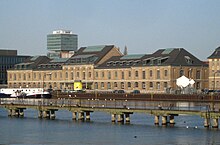
In spring 2004, the German headquarters of the TV broadcaster MTV Germany moved from Munich to Stralauer Allee 6/7 in the former BEHALA warehouse west, which had been extensively renovated. To the west of it, a new building was built between 2006 and 2007 for the Viacom family of transmitters ( VIVA Germany , Nickelodeon Germany and Comedy Central Germany ) belonging to the group . With a square floor plan, the building has an edge length of around 40 meters and is around 19 meters high. It houses offices for 300 employees, archive, ancillary and technical areas as well as an in-house day care center. The brick facade of the new building was matched in stone format and color to the neighboring warehouse.
A-Medialynx GmbH
The former port office of BEHALA at Stralauer Allee 8 was renovated in 2007 and moved into by A-Medialynx GmbH , a full-service provider for TV productions and satellite transmission technology owned by Helmut Audrit .
TV shipyard
Between July 2007 and February 2009, a new building was erected between the former port office and the BEHALA canteen. The television yard houses two modern television studios, editing suites and offices on a total area of around 6,000 m². It is used by the sister companies A-Medialynx GmbH and fernsehwerft GmbH , which are already located in the neighboring building (Stralauer Allee 8) . The television yard was designed by the Berlin office of Dieter Hoffmann Architects .
Since July 2009, Sat.1 breakfast television and Sat.1 magazine have been produced in one of the two studios by maz & more GmbH, a wholly-owned subsidiary of N24 , which emerged from the Sat.1 central editorial team on January 1, 2009 .
Cigar Duke
The former harbor canteen of BEHALA at Stralauer Allee 9 was built in 1909 and is a listed building. Like the former port office, it was renovated in 2007 and initially moved into by A-Medialynx GmbH , which owns the building. Since 2008 she has been renting 200 m² of space to Zigarren Herzog Vertriebsgesellschaft mbH , which has set up a salon and a 60 m² humidor for cigar storage there.
Labels Berlin 1
The former warehouse east of BEHALA at Stralauer Allee 10/11 was in 1913 by Friedrich Krause built and is due to its brick facade , pilasters and Gesimsbändern of limestone and art rock as a testimony of the representative industrial architecture of the turn of the 20th century under monument protection . In 2006 it was extensively renovated and rebuilt by Labels Projektmanagement GmbH & Co. KG in close cooperation with the future users. After the construction work was completed, eight fashion companies set up showrooms at the site, including Hugo Boss , Esprit and Tom Tailor . In 2009/2010, the new label Berlin 2 was built on the neighboring property as a supplement (see: Labels Berlin 2 ).
Labels Berlin 2
To the east of Labels Berlin 1 , the new Labels Berlin 2 building was built in 2009/10 as a location extension, despite a referendum in July 2008 . The design comes from the Basel architects HHF . The opening took place on January 19, 2010.
The building has a greenish concrete facade, on which the two differently spanned sinusoids made of exposed concrete stand out. The five floors with a total usable area of 7,000 m² offer 22 fashion companies space for showrooms. There are function rooms for fashion shows, parties and restaurants on the ground floor. A green lounge was created on the roof. The two building labels Berlin 1 and 2 were transferred to SEF Select Evolution 1 Ltd. in March 2012 . & Co. KG sold.
Southern bank of the Spree from east to west
Treptowers
The Treptowers are a four-part building complex directly on the Elsenbrücke . The highest part is a tower that can be seen from afar, which at 125 meters is the tallest office building in Berlin. Existing buildings of the former VEB Elektro-Apparate-Werke Berlin-Treptow , in which production took place until 1995, were integrated into the new building. Roland Ernst Städtebau GmbH acted as project developer and client. After the complex was completed in 1998, it was taken over by Allianz SE - the buildings primarily serve as the company's Berlin branch, but parts are also rented out.
TwinTowers
The building complex between Hoffmannstrasse and Spree consists of four parts: two 15-storey towers and two five-storey “ Karrees ”. It was designed by the Stuttgart architects Kieferle & Partner and completed in 1997. The more than 24,000 m² office and commercial space is rented to various companies, 6,700 m² of which to 50Hertz Transmission GmbH .
arena
The Arena Berlin at Eichenstrasse 4 is an event location in Berlin-Alt-Treptow . It is a former omnibus hall of the Berlin transport company. When it was built in 1927 by the architect Franz Ahrens, it was the largest self-supporting hall in Europe with over 7000 m². During the Second World War it was used by the National Socialists as a maintenance hall for tanks and military equipment, then from the late 1940s to the early 1950s as a refugee camp. From 1961, due to its direct proximity to the wall strip, it was only accessible to GDR border troops and BVG employees with special permits. In 1993 it was closed as a location for the public transport company due to its dilapidated structure. After its renovation in accordance with listed buildings, the ART Kombinat association began using the hall for cultural purposes in 1995. Today concerts, lectures, conferences, galas, TV shows and other events take place there.
The overall ensemble of the Arena Berlin also includes the Glashaus theater and event location , the MAGAZIN exhibition hall connected to it , the Badeschiff and the club and restaurant ship Hoppetosse .
GSG farms
The commercial yards at Schlesische Strasse 26 and 27 belong to the Berliner Gewerbesiedlungsgesellschaft mbH (GSG) .
The commercial center at Schlesische Straße 26 is characterized by a traditional clinker brick facade and lattice windows. Commercial lofts were set up in it after the renovation. The business park is also known under the colloquial name Wasserschloss , which results from its location at the mouth of the Landwehr Canal into the Spree.
The building complex at Schlesische Straße 27 was built in 1926/1927 by the Berliner Mörtelwerke and is partly listed. In 1997 it was expanded to include new buildings. The Berliner Gewerbesiedlungsgesellschaft mbH (GSG) was in charge . All parts of the building are six stories high. The total of 32 rental units are used by various companies as business, office, production and commercial space.
Industrial palace at the Silesian Gate
The industrial park at Schlesische Straße 28-30 was built between 1907 and 1908 and is a listed building. It is known colloquially as the industrial palace at the Schlesisches Tor . The rooms are rented by the Verwaltung Berliner Grundstücke GmbH , which is also based there. The building is particularly striking due to its steel and glass superstructure, which protrudes towards the Spree at the fourth floor.
Victoria Mill
The Viktoria-Mühle at Schlesische Straße 38 was built from 1891 to 1898 and is a listed building. The original building ensemble includes three transverse buildings; the adjoining storage facility in Cuvrystraße and the factory building in Falckensteinstraße, on the other hand, were only built after the Second World War.
Overall, the complex is divided into the individual components of a grain silo with cleaning and silo system, mill building, flour storage facility with flour silo and a residential and commercial building. Grain was processed and stored on the site until the late 1960s. The Club 103 disco was also located here until September 2008 .
The redesign of the area was planned by the architects aschenbrenner mosler & others . In the renovated buildings, among other things, studios, residential and office lofts were set up, which are managed by the local Artus Lagerhaus GmbH .
Wissinger Höfe
The Wissinger Höfe were once the largest seed and grain store in Europe. The wholesale merchant Julius Wissinger had this warehouse built as a south-east warehouse by 1908 . They are located at Pfuelstraße 5 in the immediate vicinity of the Spree and are under monument protection. From the end of the 1990s to the beginning of the 2000s, they were extensively renovated and repaired. Mainly office and commercial lofts as well as music rooms and studios were set up, in which record companies and modern service companies have settled. The building complex is owned by Berliner Kuthe GmbH , which rents the rooms.
Sewing machine factory
The former Singer sewing machine factory at Köpenicker Straße 8/9 was renovated in the 1990s. The listed building complex includes a factory building built around 1860 and a clinker brick building from 1927, which was used by Singer as a warehouse and office building.
Most of the renovated rooms are now offices; At the beginning of 2009 around 3,000 m² were occupied by 200 employees of the media and communications company init . A private two-wheeled museum is located in an outbuilding.
Jam factory
The residential and factory building in Köpenicker Straße 10a was built in Art Nouveau style in 1889 directly on the Spree. The apartments in the front building were originally stately officers' apartments. Behind it is the former jam factory with two transverse buildings. The complex is under ensemble protection .
The entire factory was extensively renovated, modernized and expanded from 2004 to 2005. The factory buildings were converted into loft and penthouse apartments and balconies were added. The premises are managed and rented out by Erber Immobilien .
Army bakery and Viktoria-Speicher II
The army bakery was built in 1805 at Köpenicker Straße 16/17 and was part of the Royal Prussian Provision Office . From 1888 to 1893, the complex was expanded by five buildings, which - apart from a mill - are still preserved today and are under monument protection.
The representative facade of the Heeresbäckerei is six stories high and consists of exposed brickwork made of yellowish clinker. Inside there are cast iron supports and Prussian cap ceilings. The total converted area is 9,300 m².
As part of Mediaspree , office and commercial lofts are planned for the entire building complex. The rooms are rented out as storage space by Polaris Immobilienmanagement GmbH . Among other things, the lounge club with the Spindler & Klatt restaurant is also located on the site .
Velvet factory
The property at Köpenicker Straße 18-20 is around 10,000 m² in size and has two historical buildings that were built between 1852 and 1881. The Berlin Velvet factory used to be located here. Special features are high ceilings, cast iron supports and exposed brickwork. The buildings were renovated from 2008 to 2009 by Nicolas Berggruen Holdings GmbH and are now rented out as offices, apartments and creative lofts. At the end of October 2008, the designer furniture store Exil Wohnmagazin opened its new location at Köpenicker Strasse 20 on 6,000 m².
ver.di federal headquarters
From November 2002 to July 2004, a new office building was built at Paula-Thiede-Ufer 10. The building was designed by the architects Kny & Weber and is the first completed part of the major Spreeport project (see below). It is 154 meters long, 65 meters wide and 35 meters high. Its facade consists of glass, steel and red Röben clinker bricks. The main entrance to the Spree is a 23 meter high atrium . The building has a large conference center with modern media technology, catering areas, a publicly accessible bookstore with the Gutenberg Book Guild and its own dock on the Spree. The main tenant since August 2004 has been the United Service Union , ver.di , which uses the building as the federal headquarters and administration .
BDA federal office
The Bund Deutscher Architekten (BDA) has set up its federal office in the office building at Köpenicker Straße 48/49 . The location also houses the offices of various architecture and engineering companies and the German Architecture Center (DAZ), an initiative of the BDA. It was redesigned in 2005 and has since held exhibitions, congresses, meetings, conferences, workshops and lectures in two halls and three seminar rooms.
Spree-Carrée
The Spree-Carrée office and commercial building at Michaelkirchstrasse 17/18 in Berlin-Mitte combines a Wilhelminian-style building and a new building. When renovating the old building, an attempt was made to preserve the historical character of the facade with its typical glazed brick cladding. In the rooms that are rented by Bodenkontor Liegenschaften GmbH , in addition to various companies and companies, there are also some social institutions, including the German Association .
Josetti courtyards
The commercial building is located at Rungestrasse 22-24 near the Jannowitzbrücke . All parts of the building on plots 22-27 were built in 1906 by the Jewish owner Kreslowsky on a former timber yard. They consist of two complexes that extend as far as the Spree and are listed buildings. The building ensemble is a good example of the Berlin commercial courtyards clad with glazed bricks at the end of the 19th century. Right from the start, the facility housed a wide variety of businesses. It first became known through the establishment of the Manoli cigarette company (from 1908). After the takeover by the Reemtsma Group , production at the Josetti GmbH cigarette factory was also relocated to Rungestrasse in 1927. Since the beginning of the 20th century, the courtyards have housed a wood and metal processing company, a documentary film studio , the GDR chip manufacturer Robotron and, after the fall of the Berlin Wall, the Berlin Senate Department for Finance. It was only when all parts of the building were quickly renovated for the financial administration that the well-known Manoli -M was knocked off the support capitals in the building. Today only the Josetti lettering above the entrance portal tells of the former function of the commercial center.
The courtyards are owned by OCEANIS S.A. , which has been offering around 13,000 m² of usable space for rent since November 2010. The care and administration was transferred to SorgerTec Hausverwaltung AG . Around 250 different tenants have settled here, primarily from the fields of design, art, culture and communication. Many are self-employed, freelancers, small and expanding as well as start-up companies. A rental is for an indefinite period with a two-month notice period.
At the end of 2012, the new owner began to give notice to the majority of the tenants in order to let the rental space to larger companies such as Daimler AG and Fab.com .
Jannowitz Center
The Jannowitz-Center was planned by the architectural office Hentrich-Petschnigg & Partner (HPP) and built from 1994 to 1997. It is located directly on the Jannowitzbrücke at Brückenstraße 5/6, opposite is the embassy of the People's Republic of China . It is a modern office and commercial building complex in which mainly office tenants and retail outlets on the ground floor have settled on 32,750 m² of usable space. The main tenant is the Senate Department for Urban Development and the Environment. The property is owned by Dazzle Zwei Berlin GmbH , based in Frankfurt / M., Which has it managed by BNP Paribas Real Estate Property Management GmbH .
Projects planned or under construction
Northern bank of the Spree from west to east
Spree Urban
Spree Urban is a planned urban district that is to be built on the two properties at Holzmarktstrasse 19–24 and 25–30. The properties flank the railway line from the west and east and were acquired by BSR in 2004 through its holding company SpreeUrban-Entwicklungsgesellschaft mbH & Co Immobilien KG . However, they were not intended for personal use, but were to be marketed economically. The design by the Berlin architects Staab Architekten GvAmbH won the internationally advertised implementation competition .
A development plan decided in July 2006 provided for six 36 to 43 meter high buildings and a tower 82 meters high to be erected on the site. The distance to the bank of the Spree was supposed to be ten meters, whereby the building structure would have towered over most of the way six meters deep. In order to give the public access to the banks of the Spree, openings were planned towards Holzmarktstrasse. After their completion, the buildings were to be occupied by offices, retail, catering and a hotel; in addition, a residential share of 20 percent was planned in the southern part. Club Bar 25 was on part of the premises until September 2010 .
The bidding process for a heritable building right was surprisingly won in October 2012 by a cooperative around the former operators of Bar 25. Deviating from the original development plan, this strives for a mixed use of start-up center, student residence, artists' village, club and hotel.
Hotel Spreeport
Until 2011, Club Maria am Ostbahnhof and the former administration building of GASAG built in 1936 were located on the premises at Stralauer Platz 29–31 . The Kilian Projektmanagement Berlin GmbH wanted to pay off the existing building and a 3-star plus hotel built in its place. The necessary preliminary building permits have already been issued. The plans went hand in hand with the major Spreeport project on the southern bank of the Spree (see below). The designs came from the architects Thomas Müller and Ivan Reimann.
The hotel was to have 210 rooms on a total of seven floors. A large conference and conference center, restaurant, bar and lobby were also planned. The facade facing Stralauer Platz should have a surface made of natural stone. In addition to the hotel, another building with space for living and office lofts was to be built under the name Riverside .
According to the citizens' initiative Mediaspree sink , the building project was abandoned in late summer 2008. New considerations by the state of Berlin therefore include two office and hotel blocks with a bank distance of 36 and 26 meters respectively, as well as a green area. [outdated]
Columbus house
Under the name Columbus-Haus , three eight-story office blocks are to be built at Stralauer Platz 35, between Ostbahnhof and the Spree. The complex is not related to the former Columbushaus that was once located on Potsdamer Platz . The project consists of three elongated, L-shaped parts of the building that could also be realized and marketed individually. The facade is to be built from stone on the street side and from glass on the Spree. It leaves a ten-meter-wide strip free for a planned riverside path, which it overlooks on the upper floors. The roof terrace with wooden planks and the wooden walkways in front of the offices should be reminiscent of a boat deck, while a raised staggered floor should evoke associations with a captain's bridge. The interior design of the 1,600 m² floor space is flexible.
The building permit for the Columbus House was granted in 2004 and extended in 2008. However, the original owner, Wayss & Freytag AG Projektentwicklung based in Frankfurt / Main, has sold the property and the building permit to a Spanish company. They will probably not pursue the office project any further, but will submit a new building application, in which residential use will predominate. The YAAM (Young African Art Market) sports and culture center has been working with young people on the site since 2004 .
Post area with post station
The post area is around 4.2 hectares of land near the Ostbahnhof, which is in the west by the Paris Commune Street, in the north by the railway tracks, in the east by Mariane-von-Rantzau-Strasse and bounded in the south by Mühlenstraße. In the center of the site is the listed post station , which was built from 1906 to 1908 based on designs by the then post office building officer Wilhelm Tuckermann . It is 4,300 m² in size and includes two large mail loading halls, a packing chamber and a track hall. The premises are primarily used by the FritzClub of the youth broadcaster Fritz as an event location and for concerts, but there are also often exhibitions (including body worlds ) and various other events, for example the Berlin Fashion Week .
A new urban quarter for offices, creative companies, apartments, hotels, leisure, gastronomy, retail and retail-related services is planned in the vicinity of the Postbahnhof. It is to be linked to the planned park on the Spree (see below) via so-called "Spree windows" . The development plan specifies building blocks with a height of 26 and 37 meters; however, two new high-rise buildings with a height of 96 and 118 meters respectively are planned. The citizens' initiative Mediaspree sinking criticized the project above all the dimensions of the building mass, the resulting shading and the low proportion of living space of 16.6 percent of the total floor area.
Park on the Spree
The park on the Spree is around 2.1 hectares of public green space that is to be created between the post office area (see above) and the Spree. The Brommysteg (see below) is to be built at its eastern end. The park is understood as a continuation of the Spreeuferpromenade to the east of the East Side Gallery (East Side Park, see above). It was commissioned by the Friedrichshain-Kreuzberg district office and developed by the Häfner / Jiménez office for landscape architecture . The construction costs are 620,000 euros.
Like the promenade, the park is divided into two areas. For reasons of monument protection, the wall and the central former column path are preserved. The space between the Wall and the Spree will mainly be designed as an extensive lawn; Around 80 Japanese cherry trees are to be planted towards the river . They stand on the elongated area above the slope edge and are divided into individual blocks. A jetty for liner traffic is to be created in the middle of the park. A so-called “Globe Theater” is planned for the western part, which will shake through the culture and circus tent . could be used, which is already at the site today.
Living levels
Living Levels is a residential high-rise located at Mühlenstraße 60. The property owner and project developer is the Berlin-based Living Bauhaus group of companies . The design comes from the architects nps tchoban voss GbR Architekten BDA .
The building is a 14-storey residential tower with a lobby and parking garage on the ground floor and a café / restaurant on the Spree side in the basement with access to the riverside path. The building is around 60 meters high and has a ten-meter-wide promenade to the banks of the Spree. The rear of the building (north side) is aligned along the "Wall" monument of the East Side Gallery. Originally the building was supposed to form the end of a chain of individual houses on the banks of the Spree, which, however, except for the planned Waterfront Living project on the neighboring property at Mühlenstrasse 61-63, were reversed. The reconstruction of the Brommybrücke is planned on the west side of the planned residential tower . Its implementation will probably only be seriously considered when the projects on the post office area (see above) and on the Anschutz site (see below) have been completed and an infrastructure close to the apartment has developed. Construction began on February 27, 2013, and the topping-out ceremony took place on April 17, 2014. The building facade has now been completed. Complete completion is planned for autumn 2015.
Anschutz area
The so-called Anschutz site , named after the American investor Philip F. Anschutz, is being built in the vicinity of O 2 World Berlin . It is a city district with around 520,000 m² for leisure, sports and recreation areas as well as for retail, offices and apartments. To the west of O 2 World Berlin, for example, an “entertainment center” is planned which will, among other things, house a “currywurst museum”. Furthermore, five high-rise buildings between 50 and 138 meters are to be built; most of the other buildings are around 28 meters high. Apart from a children's playground, no open spaces are planned.
Quarters in orange
The quarter in Orange is a project of the Berlin city cleaning company (BSR) at Mühlenstrasse 9/10. Until 2008, however, only the customer service center had moved into the new location; the head office is in Tempelhof. According to the investors, the area between Oberbaumbrücke , East Side Gallery and O 2 World Berlin offers further development potential and can be flexibly expanded. Additional buildings could be erected on various construction sites, for example to create up to 4,000 m² of retail space.
Skyscraper at the Elsenbrücke
The open spaces of the Osthafen (Stralauer Allee 3–16) are to be built on with a chain of 20 and 24 meter high buildings close to the banks of the Spree. A 90 meter tower is planned for the Elsenbrücke , which together with the Treptowers belonging to Allianz Versicherung on the other side of the bridge will form a so-called “city gate”. In March 2008, the owner BEHALA was granted preliminary building permits, whereupon it sold the building plots in question to investors. The development plan for the east port has not yet been finalized. The citizens' initiative Mediaspree is turning against the high-rise plans and the dense bank development. Since July 2008 she has been partially supported in her demands by the District Assembly (BVV) of Friedrichshain-Kreuzberg , which has promised to prevent the planned high-rise building on the Elsenbrücke.
Southern bank of the Spree from east to west
Fanny-Zobel-Strasse
The property at Fanny-Zobel-Straße 13-21 is located between the Treptowers and the TwinTowers . It is currently undeveloped and was acquired in 1999 by the third company Adler Real Estate GmbH & Co. KG . In the fall of 2011, the approximately 7,000 square meter property became the property of Agromex GmbH & Co. KG , which subsequently launched an architecture competition. 14 national and international architects submitted their proposals for the development of the property. The winner was the Berlin office Pysall Architects , whose design includes three solitary individual buildings. In addition to two residential towers measuring 99 and 110 meters, a new hotel building with 200 rooms, a 3000 square meter public park and an underground car park with 300 bicycle and 400 car parking spaces are planned. The development plan procedure required for this is currently running.
Marina at the east harbor
Including the former border security pier, which extends several hundred meters in the middle of the Osthafen, a marina with a clubhouse and the Spree balcony is to be built on the Spree . In addition, a bar with lounge and landing stages for water taxis and liners are planned. The Arena Berlin had a corresponding design made by the architects Grazyna and Jerzy Wilk.
New Spree storage
IVG Immobilien AG is planning the new Spreespeicher at the corner of Cuvrystrasse and Schlesische Strasse . The approximately 10,000 m² property was last used for a flea market. The buildings now planned are two 160-meter-long, five-story buildings with three additional storeys. They are to be built in the traditional office building style and open towards the Spree. It is intended to be used for office lofts, small-scale retail and catering. The building permit for this project expired at the end of November 2008 and was extended for a further year. Further details on the current planning are not known.
May-Ayim-Ufer double wharf
The Gröbenufer double pier (today: May-Ayim-Ufer ), which was built in 1895, and the catacombs connected to it underground will be renovated and renewed from January 2007 to December 2009 in accordance with historical monuments. Once the repair work has been completed, it will be used for gastronomic and cultural purposes, for example for exhibitions. Docking points for ferries and water taxis are planned for the publicly accessible piers. In addition, the importance of the quay as a place of remembrance for victims of the Wall should be emphasized via an information board. An artistically designed signal mast will remind of the lighthouse originally in the center of the facility, which was destroyed in World War II. The project is being implemented as part of the urban development funding program Stadtumbau West . Its total cost is around 2.5 million euros.
Brommysteg
Until 1945 there was another Spree crossing about halfway between the Schillingbrücke and the Oberbaumbrücke - the Brommybrücke . It was built from 1907 to 1909 and blown up by the Wehrmacht during the Second World War to make the advance of the advancing Red Army more difficult. A reconstruction of the Brommybrücke was planned as part of the Mediaspree project . After public protests and a negative referendum , the plans for a road bridge were abandoned. The last drafts provide for a temporary “artificial bridge”. This would be built in a simple scaffolding with integrated wooden planks and should offer space for rest and relaxation on several platforms as well as for events and functions. Two towers belonging to the ensemble could be illuminated with media and used for video installations. The construction costs for this footbridge should amount to less than one million euros.
On the other hand, there are also various other designs, including one by the architect Gerhard Spangenberg for a 14.5 million euro habitable Brommy Bridge. And in the event that the Brommybrücke is built as a footbridge, there are plans to build an additional road bridge for buses and trams at a distance of 200 m at Manteuffelstrasse. The citizens' initiative Mediaspree sink fears a later opening for car traffic and a drastic increase in the volume of traffic in the adjacent residential areas.
Viktoria-Speicher I
The area around the Viktoria-Speicher has a length of approx. 300 meters and a width of 140 meters and a size of around 4.2 hectares . It is located at Köpenicker Straße 20a – 29 and is bordered by the Schilling Bridge in the west, the Spree in the north, the former Velvet factory in the east and Köpenicker Straße in the south. There are several single-storey halls on the property, but it is shaped by the Viktoria-Speicher, which was built by Franz Ahrens in 1910 . As a testimony to modern industrial architecture, it is a listed building.
The halls are used by around 20 to 30 companies that have rented the space from the property owner BEHALA. Among other things, the building materials dealer Dämmisol had set up sales and storage areas. However, since BEHALA wants to sell the property to the highest bidder as part of Mediaspree , existing rental contracts have been terminated. That could happen by December 31, 2008 at the latest.
The halls could be demolished in the course of re-planning. The Viktoria-Speicher was restored by February 2009. It is the heart of a new district center with shops and cultural institutions. It is to be inaugurated in April 2009 and can also be reached by water. In addition, there is an urban planning draft up to the decision to draw up a development plan. It comes from the architectural office Mola Winkelmüller and includes a riverside promenade, green strips and multi-storey buildings.
Spreeport
Spreeport is a major project by HOCHTIEF Construction AG in cooperation with ALEX Bau GmbH and Kilian Projektmanagement Berlin GmbH . This is the area on the Paula-Thiede-Ufer between the ice factory and Engeldamm. The first construction phase - the ver.di office building - was completed in July 2004; the second construction phase at Köpenicker Straße 36–38 is currently being implemented. In the 19th century there were wood storage facilities and markets as well as lime barns at this point on the Spree; A prefabricated building was erected in the 20th century. Now new office and commercial space as well as apartments, apartments and boarding houses are to be built on the site. The offer is primarily intended to address IT companies, bio-tech and high-tech companies as well as home and teleworkers.
Ice cream factory
The former ice factory of Norddeutsche Eiswerke AG is located at Köpenicker Straße 40/41 and is one of the oldest preserved ice cream factories in Germany. Artificial ice was produced in it from 1896 to 1995. The total area of around 11,000 m² consists of two courtyards with residential and factory buildings. It also includes three cold stores as well as a boiler and machine house, which is characterized by a clear, neoclassical brick architecture based on the model of early modernism .
In 1995 the Treuhand Liegenschaftsgesellschaft (TLG) took over the management of the property. In November 2008 she sold the listed ice cream factory to TELAMON GmbH in Bochum . This is also the owner of the Radialsystem V on the opposite bank of the Spree and had an extensive inventory and detailed planning carried out. Concrete demolition plans by the architect Ivan Reimann from 2005, which suggested a new building made of glass, seem to be off the table. A citizens' initiative was founded to maintain the ice cream factory. When the renovation of the ice cream factory will start is not yet foreseeable. However, it is already clear that future use should be in the creative industries.
The residential buildings on Köpenicker Strasse as well as the cold stores and warehouses in the rear part of the area are still owned by TLG Immobilien. There is a positive preliminary building permit for the submitted planning, which includes a demolition permit for the historic cold stores. In these areas, too, future use has not yet been determined. However, it is planned to build a new office location consisting of new buildings and existing residential developments.
The existing residential building and the cold store are being renovated in accordance with the preservation order.
Other objects in the Mediaspree area
Northern bank of the Spree from west to east
- Berlin Jannowitzbrücke station , S- and U-Bahn station between Holzmarktstrasse and Jannowitzbrücke, part of the Stadtbahn viaduct, technical monument
- Holzwerk / Holzmarkt , Holzmarktstrasse 25 (until autumn 2010: Bar25 )
- Main pumping station of Berliner Wasserbetriebe , Holzmarktstraße 32, pumping station and headquarters of the control and information system waste water (LISA)
- Radialsystem V , Holzmarktstrasse 33 (former sewage pumping station V)
- Berlin Ostbahnhof , Koppenstrasse 3, long-distance, regional and S-Bahn station with shopping arcade, connected office complex and InterCityHotel
- Maria am Ostbahnhof , Stralauer Platz 33/34, former club and event location
- Young African Art Market (YAAM), Stralauer Platz 35, sports and cultural center for youth work
- Speicher , Mühlenstrasse 78–80, discotheque and restaurant, former mill warehouse and grain silo
- East-Side-Gallery , Mühlenstrasse, 1.3 km long section of the Berlin Wall , largest open-air gallery in the world
- former Higher Web School , Warschauer Platz 6–8, listed building on the western edge of the newly designed Oberbaum City , until 2006 used by the University of Applied Sciences for Technology and Economics
Southern bank of the Spree from east to west
- Visionaries Club , Am Flutgraben 2, café and event location
- Art factory at Flutgraben, Am Flutgraben 3, art and culture association
- Freischwimmer, Vor dem Schlesisches Tor 2, bar and restaurant, former boat rental and workshop
- Cafe Zur Pump , Vor dem Schlesisches Tor 3, former wheelhouse of the Royal Water Inspectorate and the only remaining excise house on Lohmühleninsel , listed as a historical monument
- Aral petrol station , the oldest preserved petrol station in Berlin, a listed building
- Otto Rauhut GmbH & Co., Schleusenufer 4, joinery and interior work
- Cuvrybrache , Cuvrystraße 50
- Zapf-Umzüge, Köpenicker Straße 14, to date the seat of Europe's largest moving company, which will probably move away in the medium term
- former bunker boathouse, Köpenicker Straße 48/49 (until 2011: Kiki Blofeld , club garden and event location)
- KaterHolzig, Köpenicker Straße 50-52 (former soap factory)
- Black Canal , Michaelkirchstrasse 22/23, Wagenburg
- Berlin-Mitte thermal power station, Köpenicker Strasse 59–73, combined gas and steam turbine power station with combined heat and power
Spree bridges from west to east
criticism
The Mediaspree project is subject to extensive criticism. Among other things, it is feared that long-term residents will be displaced due to higher maintenance costs resulting from the targeted gentrification of the surrounding residential areas. The term “revaluation”, used synonymously in this context for the rise in prices and cultural change, is regarded as rhetorical misinformation.
The privatization of public space and the "urban redevelopment from above", in which the interests and fears of the residents are not taken into account, are also criticized . There is talk of a "partially privatized urban policy", since the Mediaspree community sees itself primarily as a point of contact for projects and investors and shows little interest in the opinion of residents, while the infrastructure of roads, bridges and lighting required for Mediaspree is provided by the public sector be financed. Among other things, reference is made to the subsidies amounting to millions with which companies that have moved in, such as MTV and Universal Music , were supported by the Berlin Senate . It is also felt to be illogical that the Senate welcomed and financially supported the construction of O 2 World Berlin, although there was no shortage of event halls in Berlin. After the basketball club Alba Berlin relocated its home games to O 2 World Berlin, the underutilization of its former home ground, the Max-Schmeling-Halle in Prenzlauer Berg , has to be compensated for by public subsidies .
The redesign of wild-growing sections of the banks of the Spree is also criticized. The now few and narrow, publicly accessible bank areas, which are mostly video-monitored, are criticized. The fears of a park at the East Side Gallery marked by billboards have come true in the eyes of the critics. They could not understand that a 45-meter-long section of the East Side Gallery was removed for the large-format screens at O 2 World Berlin and an associated landing stage for excursion boats and water taxis, despite the monument protection.
Subcultures complain about the expulsion of numerous alternative cultural projects such as the Black Canal , the Köpi , the YAAM or many facilities that have already been demolished such as the Ostgut , the Casino or the RazzleDazzle in favor of large, commercial event facilities and companies. In their view, this development is at the expense of cultural diversity. The documentary Bar 25 - Days Out of Time describes, among other things, the fight against the Mediaspree project and the closure of Bar 25 .
Another point of criticism was the recognition of the Mediaspree e. V. as a non-profit organization , although it only admitted property owners and investors as members. The critics' opinion was that behind the goal of ensuring long-term and sustainable development into an efficient and attractive business and cultural location, only the enforcement of private-sector interests was hidden. In addition, the work of the association was supported with public money. The association dissolved on December 31, 2008.
The new event hall O 2 World Berlin results in increased through traffic, which is also criticized by the protesters. However, they were able to ensure that the planned reconstruction of the Brommy Bridge as a road bridge in connection with this was for the time being abandoned .
Protests

So far there have been numerous protests against the restructuring plans, which have been supported by institutions such as the Hedonist International , the Fuckparade and the Transgenial CSD , as well as a successful referendum.
Citizens' initiative Mediaspree Lowering
The protests are mainly coordinated by the citizens' initiative Mediaspree , which was initiated by the architect Carsten Joost, among others. Under the slogan "Spreeufer für alle!", The alliance is organizing information events for residents so-called "Kiezspaziergangs" against the project and accompanied a petition by citizens to help shape the banks of the Spree.
The initiative group consists of the realpolitically oriented working group Spreeufer and the more left-wing extremist working group Spree Pirates . He sees himself as a representative of the interests of those who want a bank of the Spree as a green and cultural area with a variety of uses. Central requirements are a minimum distance of 50 meters to the bank of the Spree for all new buildings, compliance with the Berlin eaves height of 22 meters and a bicycle and pedestrian walkway instead of a new road bridge. In addition, existing buildings should be integrated into an open space concept and supplemented by pavilions with public uses. The remaining new construction areas are to be parceled out in such a way that not just a few major investors can get involved, but many users, especially non-commercial, cultural initiatives. The initiative group accuses the district of privatizing public properties.
From the point of view of the citizens' initiative, the planning of Mediaspree is squandering the historic opportunity to develop a river bank zone as a recreational area with a high proportion of open space. The planned riverside path and the pocket parks are not sufficient for a metropolis like Berlin. The entire project is perceived as an investment in the high-price sector, which is primarily about profitable bank development with a privatized view of the Spree, while the social sector is disregarded. It is feared that the planned “upgrading” of the area will lead to rising rents, anti-social development of the city and the destruction of culture.
Citizens' decision "Spreeufer for everyone!"
Against the plans of Media Spree was born on 13 July 2008, a referendum carried out in which a free shoreline of 50 m and the absence of high-rise buildings as well as the planned new road bridge over the Spree is required. The required number of support signatures was obtained early within five months and was officially submitted to the Friedrichshain-Kreuzberg district on March 4, 2008 . In the following referendum, the turnout of 19.1% was above the necessary 15% mark. A clear majority of voters (87%) supported the alternative proposals of the Mediaspree initiative . According to the organization Mehr Demokratie , this is the most successful citizens' initiative in Berlin to date. However, the result is not binding. While the district associations of the SPD and the Greens then demanded that the citizens' will be implemented as quickly as possible, the Senator for Urban Development Ingeborg Junge-Reyer assured the investors of planning security.
If the referendum was implemented, according to the district office, the compensation costs to the investors amounted to 164.7 million euros. However, the citizens' initiative rejects this estimate as incorrect, since the costs mentioned are the value of the entire area of the bank of the Spree affected by the referendum and the referendum only relates to the new construction areas.
Demonstrations
Under the name “Kiezspaziergang” several demonstrations have taken place through Friedrichshain and Kreuzberg, at which information about specific urban restructuring was provided at various stations and the topic of gentrification was dealt with. In addition, several bicycle demonstrations took place around the Mediaspre area before the referendum.
The “Investors Cheering”, a demonstration on the Spree, during which the demonstrators accompanied a boat trip by the Mediaspree investors with rubber dinghies and pedalos, which was then prematurely stopped, also caused a stir.
At the "Spree Parade", a large demonstration the day before the referendum, to which several organizations and the interim users of the Spree bank had called, around 5000 people came together.
Around 1,500 people protested on September 10, 2008 against the opening of O 2 World Berlin, which was screened off by a massive police presence against the demonstrators.
One year after the referendum, the Megaspree campaign alliance of residents, political groups and cultural projects demonstrated on July 11th, 2009 against the "marketing and privatization" of the banks of the Spree. According to the organizers, around 8,000 people took part in the demonstration. A year later, on July 10, 2010, around 5,000 people again demonstrated against Mediaspree, gentrification and the “concreting” of Berlin as part of the Megaspree demonstration .
The demonstrations against Mediaspree continued in 2010. On June 6, 2010, around 2000 people protested against Mediaspree under the motto “Entern Mediaspree”.
Art projects
A music and video project with the activist Fatma Souad was created in 2007 in Friedrichshain-Kreuzberg against the Mediaspree project . The queer rap is a political walk through individual places in Berlin and provides critical information about the corresponding urban development.
Under the motto “Spotting away the Media Spree!”, Four short films were made in a competition in 2008 that deal critically with the project and apply for the citizens' initiative.
With their canoe project “Spreeverinselung”, the artist duo “Varsity of Maneuvers” focuses on the physical accessibility and regulation of the Spree area, which residents of the neighborhood and Berliners generally exclude.
Reactions
The Friedrichshain-Kreuzberg district had already responded to the petition for citizens on the Spreeufer für alle! reacted and accommodated the initiators in a separate proposal put to the vote. In a direct comparison, however, the initiators' alternative was preferred by the voters.
The referendum is not binding. Nevertheless, the district has moved away from some Mediaspree plans. For example, the new high-rise building on the Elsenbrücke is to be dispensed with and instead of the planned road bridge, only a bicycle and pedestrian walkway is to be built over the Spree. In doing so, he partially accommodates central points of the referendum. In September 2008 a special committee was set up in which members of the various parliamentary groups and the citizens' initiative Mediaspree sink to discuss ways of changing construction plans in line with the referendum.
The demands for a strip of shore at least 50 meters wide were also followed up. A compromise was reached with the property fund, which owns the area with the Maria am Ostbahnhof : the strip of shore there should now be 20 to 30 meters wide instead of the originally planned ten meters and offer space for a small park. At the end of February 2009, however, the Berlin Senate got involved in the negotiations. He fears claims for damages from investors should development plans be changed, and also has "serious concerns" against abandoning the skyscraper on Elsenbrücke. He therefore threatens to withdraw planning authority from the district. Mediaspree, CDU and FDP as well as the Chamber of Commerce and Industry welcome the initiative, while the Mediaspree sinking initiative fears a worsening of opportunities because it can only exert influence via the district.
literature
- Frank Pieter Hesse: The Friedrichshain-Kreuzberger Spree - urban space and monuments in transition . (PDF; 1.6 MB) Landesdenkmalamt Berlin, 2004.
- Tobias Höpner: Image as a location factor. Image production for the marketing of urban development projects using the example of “Media-Spree” in Berlin . Institute for Urban and Regional Planning, TU Berlin, Discussion Papers 55, 2005, ISBN 3-7983-1957-X .
Web links
- Sink citizens' initiative Mediaspree
- Interview with Ingeborg Junge-Reyer, Senator for Urban Development
- Mediaspree versus Spreeufer for everyone! - a balance sheet ( memento from June 12, 2011 in the Internet Archive )
- Construction project on Fanny Zobel Strasse
Individual evidence
- ↑ mediaspree.de/Zielrichtung
- ↑ mediaspree.de/Mitglieder
- ↑ a b Malah Helman: Mediaspree and the neoliberal urban redevelopment. At: abriss-berlin.de, January 26, 2007
- ↑ Spree area model. Senate Department for Urban Development and the Environment, accessed on November 26, 2012
- ↑ Information on “Mediaspree” in the Media Guide Berlin-Brandenburg ( memento of the original from October 5, 2001 in the Internet Archive ) Info: The archive link was automatically inserted and not yet checked. Please check the original and archive link according to the instructions and then remove this notice.
- ^ Protest and chaos at the opening of the O2 World . Wikinews , September 11, 2008
- ↑ Berlin is on the Spree . Information video from Mediaspree at google.com
- ↑ Funding programs for urban redevelopment east and west. ( Memento of the original from July 27, 2010 in the Internet Archive ) Info: The archive link was inserted automatically and has not yet been checked. Please check the original and archive link according to the instructions and then remove this notice. Senate Department for Urban Development
- ↑ Object descriptions mediaspree.de
- ↑ izt.de
- ↑ nhow Hotel Berlin. Retrieved on March 12, 2019 (German).
- ↑ Music & Lifestyle Hotel nhow | TCHOBAN VOSS Architects. Retrieved March 12, 2019 .
- ↑ The excavators are now rolling for Mediaspree . In: Der Tagesspiegel , August 21, 2008.
- ↑ Manoli . In: Berliner Adreßbuch , 1908, part 1, p. 1599.
- ↑ It won't be an idyll here . In: the daily newspaper , October 17, 2012
- ↑ a b c Sink the citizens' initiative Mediaspree
- ↑ Official information on the referendum “Spreeufer für alle!” In Friedrichshain-Kreuzberg on July 13, 2008 - presentation of the arguments of the District Assembly (BVV)
- ↑ Draft for the marina ( Memento of the original from October 27, 2010 in the Internet Archive ) Info: The archive link was automatically inserted and not yet checked. Please check the original and archive link according to the instructions and then remove this notice.
- ↑ Project description. District Office Friedrichshain-Kreuzberg
- ^ Draft of the Brommysteg by the Berlin architects Strecker + Partner and Gerüstbau Tisch GmbH
- ^ Drafts by Gerhard Spangenberg for the Brommybrücke ( memento of the original from October 6, 2010 in the Internet Archive ) Info: The archive link was automatically inserted and not yet checked. Please check the original and archive link according to the instructions and then remove this notice.
- ↑ a b Official information on the referendum "Spreeufer für alle!" In Friedrichshain-Kreuzberg on July 13, 2008 - presentation of the arguments of the initiators of the referendum, reason for question 2
- ^ Draft for the area around the Viktoria-Speicher by the architects Mola Winkelmüller
- ↑ Spreeport presentation
- ↑ Sketch of the new buildings on the ice cream factory site (2005)
- ↑ Visions, projects and objects . (PDF; 6.0 MB) TLG information brochure, October 2006
- ↑ Internet presence of the initiative for the preservation of the ice cream factory
- ↑ The old artificial ice factory is being revitalized. In: Berlin Week
- ↑ Felix Lee, Christina Hebel: Kreuzberger don't care about entertainment . In: the daily newspaper , April 23, 2007
- ↑ On the banks of the Spree: ugly building projects, "MediaSpree" and "Stadtumbau West" ( Memento of the original from June 6, 2008 in the Internet Archive ) Info: The archive link was automatically inserted and not yet checked. Please check the original and archive link according to the instructions and then remove this notice. at kreuzberg-info.de
- ↑ MediaSpree belongs sunk at antiberliner.de, issue 12, June / July 2007
- ↑ Kiezspaziergang: "Sink MediaSpree!" At abriss-berlin.de, April 24, 2007
- ↑ The trend is towards the loft . ( Memento of the original from September 30, 2007 in the Internet Archive ) Info: The archive link was automatically inserted and not yet checked. Please check the original and archive link according to the instructions and then remove this notice. jungle world , April 18, 2007
- ↑ "Köpi" - Mediaspree becomes concrete ( memento of the original from June 6, 2008 in the Internet Archive ) Info: The archive link was inserted automatically and has not yet been checked. Please check the original and archive link according to the instructions and then remove this notice. at kreuzberg-info.de
- ↑ Neighborhood walk: sink MediaSpree! at ostprinzessin.de, April 24, 2007
- ^ Website of the AG Spreeufer
- ↑ The Spree Pirates - Who is in the mood for MediaSpree?
- ↑ Official information on the referendum "Spreeufer für alle!" In Friedrichshain-Kreuzberg on July 13, 2008 - presentation of the arguments of the initiators of the referendum, reason for question 1
- ↑ Sink self-presentation of the Mediaspree initiative
- ↑ District Mayor Franz Schulz announces: Citizens' initiative “Spreeufer für alle” resolved . ( Memento of the original from June 14, 2010 in the Internet Archive ) Info: The archive link was inserted automatically and has not yet been checked. Please check the original and archive link according to the instructions and then remove this notice. berlin.de
- ^ Mediaspree: bitter debate about the future . In: The world
- ↑ Sink Mediaspree referendum successfully ( Memento of the original from January 18, 2012 in the Internet Archive ) Info: The archive link was inserted automatically and has not yet been checked. Please check the original and archive link according to the instructions and then remove this notice. Press report "More Democracy"
- ↑ Official information on the referendum “Spreeufer für alle!” In Friedrichshain-Kreuzberg on July 13, 2008 - cost estimate by the district office
- ↑ Political satire on the Spree . In: Der Tagesspiegel , July 2, 2008
- ↑ Paddling protest in the rubber boat . In: Der Tagesspiegel , July 12, 2008
- ↑ Mediaspree is sunk . In: Die Welt , July 14, 2008
- ↑ kreuzberg-info.de
- ^ Paul Kuhn: Demonstration with a giant baby against the Spree bank development. In: Berliner Morgenpost , July 13, 2009
- ↑ Mediaspree demonstration passed off peacefully . tagesspiegel.de
- ↑ Call for “Save your city” (PDF; 658 kB) megaspree.de
- ↑ Past the police to the bank. In: tagesspiegel.de
- ↑ Sink the Mediaspree . Music video of various local rappers
- ↑ Material for more beautiful banks of the Spree ( Memento of the original from July 27, 2011 in the Internet Archive ) Info: The archive link was inserted automatically and has not yet been checked. Please check the original and archive link according to the instructions and then remove this notice. Mock Media Spree!
- ↑ spree-verinselung.blogspot.com project Spreeverinselung
- ↑ Uwe Aulich, Anne Vorbringer: Power struggle in the Mediaspree . In: Berliner Zeitung , February 28, 2009, p. 23

